164th General Hospital Unit History
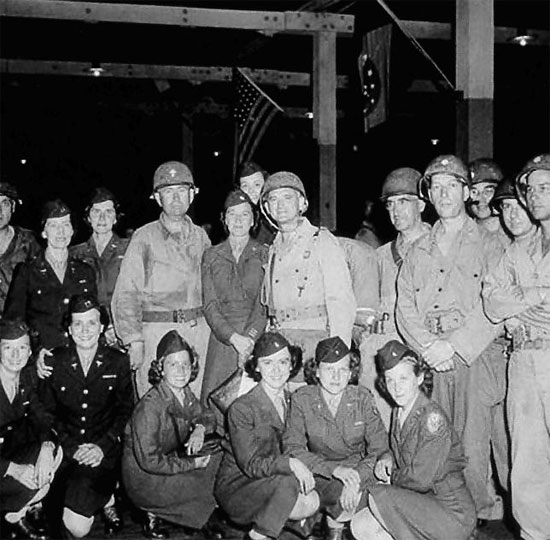
Picture taken at Hampton Roads P/E, partially illustrating 164th General Hospital Staff returning to the ZI on 2 Sep 45.
Front row from L to R: Capt. Cora V. Storey N-762277 (second), 2d Lt. Mary A. Michelitch N-762272 (third), 2d Lt. Agnes C. Stern N-762236 (fifth), 2d Lt. Dorothy F. Levitsky N-762231 (sixth).
Back row from L to R: 1st Lt. Anne Dilworth (second), 2d Lt. Laura J. Pack N-761914 (third), Capt. James H. Falls O-519057 Chaplain (fourth), Maj. Carrie E. Barrett N-7028651 Chief Nurse (fifth), Lt. Col. Frederick S. Harrell O-28561 CO (sixth), other people unknown.
Activation & Training:
The 164th General Hospital was activated on 15 July 1944, at Camp Grant, Rockford, Illinois (Medical Replacement Unit Training Center; acreage 3,349; troop capacity 453 Officers & 20,836 Enlisted Men –ed), under the authority of Paragraph 1, General Order # 30, Headquarters Sixth Service Command, Camp Grant, Illinois, in accordance with Table of Organization & Equipment, T/O & E 8-550, dated 1 April 1942.
Present on the date of activation was Lt. Colonel Frederick S. Harrell (MC), Commanding Officer, 2 Medical Administrative Corps (MAC) Officers, and a cadre of 25 Enlisted Men. The remainder of enlisted personnel to reach a total of 450 were sent in without delay. The rest of the male Officers reported in July and August. The Chief Nurse and 1 Hospital Dietitian joined on 16 July 1944, and were the only members of the female personnel present prior to the organization’s arrival at the Staging Area.
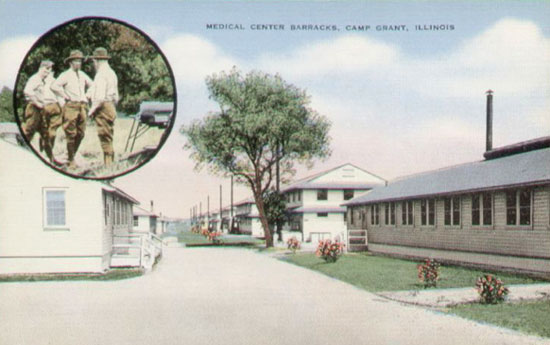
Pre-war era linen postcard showing the Medical Center Barracks at Camp Grant, Illinois. These barracks were later converted into a Medical Replacement Unit Center and became the birthplace of the 164th General Hospital.
The MAC Officers assigned to the 164th were from Camp Grant, and each had been trained in their respective trades. The QMC Officers were likewise experienced. Of the 2 Chaplains assigned, both had completed the course at the Army Chaplain School; the Protestant Chaplain having come to the unit directly from School, and the Catholic Chaplain, having had five months of active service. Of the 36 MC Officers, 13 had never engaged in private practice, but had served internships or residencies. Of these, 6 had less than six months Army experience, and 4 others had less than six months military experience. The 5 Dental Corps Officers were experienced practitioners with military experience varying from nine months to two years. The 87 female Commissioned Officers, with exception of the Chief Nurse and Chief Hospital Dietitian were all from the Third Service Command, and, of this number a total of 71 had less than six months military service prior to activation. 5 Red Cross workers constituted the civilian personnel.
The period from the date of activation to 30 August 1944, the date of departure from Camp Grant to the Staging Area, was utilized in the following ways:
- Selection of key enlisted personnel for various administrative departments and professional services, and the most feasible placement of other enlisted personnel in accordance with their Military Occupational Specialty (MOS) and qualifications as obtained from personal interviews
- Unit training with the unit as an integral group in subjects applicable to all personnel
- Sectional training with program applicable to various administrative departments and professional sections given by respective heads of departments or sections
- Insuring compliance on the part of all personal with provisions of Preparation for Overseas Movement (POM – August 1942)
On 30 August 1944, 2 trains carried the unit from Camp Grant to Camp Kilmer, Stelton, New Jersey, the Staging Area for the New York P/E, arriving there on 1 September. Here, the balance of female personnel joined the organization. The state of the 164th General Hospital as a unit was evaluated at the Staging Area, and final preparations for embarkation were completed. After completion of all processing, twelve-hour passes were granted, in a staggered manner, to permit all personnel to visit New York City.
Overseas Movement:
The unit boarded RMS “Scythia” embarking for overseas service 12 September 1944 and landed at Cherbourg, France, on 24 September 1944; it is believed that this unit, with the 165th General Hospital, which traveled in the same convoy (CU 39), were the FIRST US Army General Hospitals, to arrive directly in France from the United States! On debarkation, all male personnel were taken by truck to the Valognes Staging Area, while the female personnel went to the location of the 61st Medical Battalion (5th Engineer Special Brigade), where accommodation had been provided for Nurses.
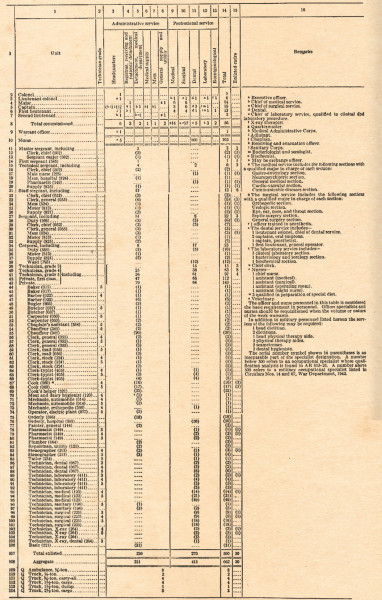
Chart illustrating T/O 8-550, dated 1 April 1942 – organization of a General Hospital, Communications Zone.
Click to enlarge
The 164th had left the ZI without competent specialists as Chiefs of Medical and Surgical Services. On 22 October 1944, Major Philip H. Livingston was appointed Chief of Medical Service. On 4 November he slipped in the mud and sustained a fractured ankle of such severity as to cause the loss of his services to the unit! Major Paul B. Sheldon, from the 2d General Hospital, replaced him on 17 November. Major George W. Gay, formerly with the 3d Evacuation Hospital, reported on 13 November as Chief of Surgical Service. Both these Officers had already from 18 to 20 months overseas experience and gave the younger men much inspiration and guidance. On 30 November 1944, the unit was reorganized in T/O strength under T/O & E 8-550, dated 3 July 1944, per Letter Headquarters ComZ, ETO, AG 3220 Op, dated 30 November 1944. Personnel changes were in progress, but not yet consummated.
First Operations in the ETO:
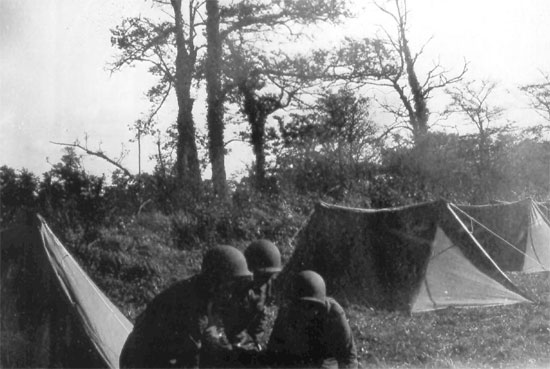
Early Oct 44 Bolleville area, prior to the availability of larger tents, 164th Gen Hosp personnel had to do with pitching their individual tents. From L to R are Nurses, Ellan, Dorothy, and Bobby…
On 5 October 1944, the 164th General Hospital moved to the site specially designated for the erection of the medical facility, some 25 miles distant from the Staging Area, 1 mile NW of La Haye-du-Puits, map coordinates T-160854. The site of the Hospital had previously been occupied by personnel of the 58th General Hospital, but the hospital had not functioned in this location! Concrete slabs for tented installations were already present and one bifurcating road and a few walks were partially completed. Company E, 1310th Engineer Regiment, was present to complete the physical plant, finish roads and sidewalks, and install lighting, plumbing, and heavy medical equipment. The process of pitching tentage, receiving equipment, and supplies, the unpacking and setting up of general equipment and construction of additional roads and walks was considerably hampered by continuous rain. While the site was established on improved roads, trucks would often bog down at Supply Depots for procurement and at the Hospital site on delivery…
The 1200-bed 164th General Hospital functioned at La Haye-du-Puits, 30 miles from Cherbourg, from 22 October 1944 to 26 May 1945 operating Hospital Plant # 4273.
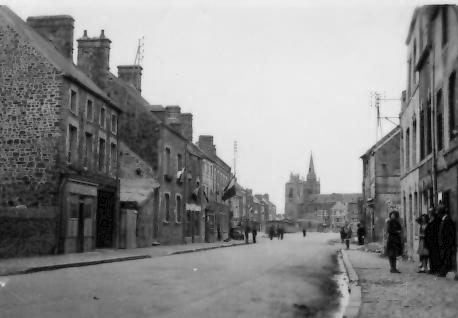
Street scene of La Haye-du-Puits, view taken in spring of 1945.
The first increment of patients, 320 in number, arrived at the 164th General Hospital on 23 October 1944. These were purposefully the “holding type”, since the surgical plant was not completed at that time. The first wing of the Surgical hut (Nissen type) was completed on 10 November; and the first surgical operation, a vein ligature, was performed the same day. The second wing was finally completed 2 December. This type of surgery had proven advantageous over tentage since it allowed utilization of a larger amount of room space over the same floor configuration; it was capable of being equipped with permanent fittings and fixtures, lighting was improved because the white-painted walls produced a light reflection, and heating could be maintained at a comparatively even temperature.
Procurement of supplies incident to food, fuel and food caused no problems. Transportation was minimal but by pooling with nearby Hospitals, and in some instances, by borrowing, it could be also used for sanitary functions and for receiving and evacuation of patients. The one way distances involved for procurement of food, materiel and supplies were from 2 miles to the nearest railroad (RR) where a portion of the coal was picked up, to 24 miles to collect mess supplies with the exception of fresh meat, and 31 miles for general supplies and fresh meats.
By order of the Normandy Base Section, dated 29 November 1944, the Hospital was authorized a 200-bed expansion. A new block of 7 tented wards was opened on 5 December, and this addition made a total of 42 wards, each with a capacity of 30 beds, possible.
Some improvisation had to be carried out, and ward, department and quarters furniture had to be constructed, as only a small amount of equipment of this nature was present on arrival! However, time and labor had to be available. Conservation of material for construction purposes had to be practiced to a high degree due to its scarcity. Conservation of materials, food, equipment and enlisted manpower was a permanent instruction, and Prisoner of War labor was therefore introduced.
Two hundred forty-nine enemy personnel, adequately guarded, were used in various capacities throughout the Hospital. They were mainly used for labor in low or non-skilled category, in disposition of discarded wastes, while those qualified were used in their own patients care, for litter bearing, and in maintenance of their own upkeep. However, if an artisan was needed, and none was available within the detachment, a PW would be used. All signs designating wards and medical installations were uniformly done by three or four German PWs. Fifty additional prisoners were obtained 29 December 1944. Prisoners were entitled to one day off per week.
All medical personnel was housed under tents. Ward tents were adequately winterized and floored with concrete. The latter were also provided for female quarters. Improvised wooden floors were installed in Officers’ quarters and those of Enlisted personnel, and adequate heating facilities provided.
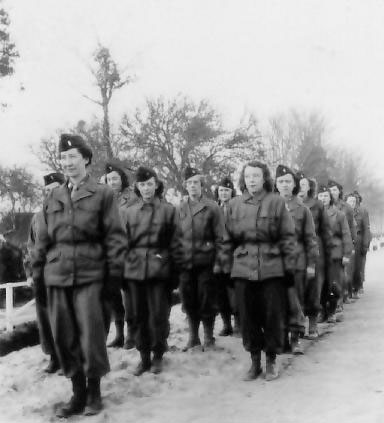
“Retreat” ceremony at La Haye-du-Puits, France, winter 1944-1945. Formation of Nurses being led by 1st Lieutenant Anne Dillworth.
This ANC Officer was in charge of the Nurses and the Medical & Surgical Technicians of the 164th General Hospital. Lt. A. Dillworth
prepared the OR schedule, and was strictly GI, she tolerated no nonsense.
Total admissions from 5 October to 31 December 1944, were 3455 – with 31% medical cases and 69% surgical cases. There were 1303 battle casualties admitted. As all cases had received prior treatment before evacuation, the following extra medical care had to be applied; secondary closure of wounds by suture and skin graft – reapplication of plaster casts – resetting of fractures – removal of foreign bodies – simple dressings – and ligation of vessels for secondary hemorrhage.
Admissions during the period numbered 3455, and can be split into:
| US Army + Allied Forces personnel | 3104 |
| French civilians | 10 |
| German Prisoners of War | 341 |
Number of dispositions were 2789 during the same period:
| US Army + Allied Forces personnel | 2640 |
| French civilians | 9 |
| German Prisoners of War | 140 |
Manner of Dispositions:
| Returned to Duty via Replacement Depots and Pools | 741 |
| Evacuated to the United Kingdom | 1550 |
| Evacuated to the 8th Convalescent Hospital | 447 |
| Transferred to other Hospitals | 51 |
France (1945):
The first of January 1945 found much to be done in way of physical site improvements, and refinements in the general operation of the Hospital. The remoteness from supply points, the mud and rain were handicaps which were to slow down improvement operations, but did not interfere appreciably with overall medical performance. Many changes occurred in the composition of the Medical Detachment due to transfer of men to other units, the rotation policy, and the requirements and demands of Army Ground Forces (AGF). During April and May 1945, male officers were more urgently needed in combat units, and accordingly were sent forward; the Nurse component however, remained more static.
Three to four hours per week were devoted to actual training for all Officers and Enlisted Personnel. Equipment for training and special aids were improvised, and much use was made of regular showing of training films. Special courses were provided for 3 Officers to I & E School in Paris; 2 ANC and 3 EM were sent to Deauville for I & E Courses, and 1 Officer and 1 Nurse went to Medical Field School near Paris.

Sign designating the 164th General Hospital, La Haye-du-Puits, France. Picture taken 4 Jun 45.
Standing from L to R: 2d Lt. Dorothy F. Levitsky, N-762231 and 2d Lt. Agnes C. Stern, N-762236.
Some services were provided with help from other American units in the area. Laundry was provided by two Laundry Sections, the 205th and 297th QM Laundry Sections, 14 miles away. Later, an additional Laundry unit was set up 10 miles away, operated by 14 EM assisted by 50 PWs. For unit personnel, a small hand laundry was operated by PWs in the area reserved for Officers and Nurses, while EM used the QM Laundry, and French civilians for cleaning woolen clothing.
Food was excellent and shipped over from the States in large quantities, and a few French grown vegetables and natural eggs were served after proper inspection at issue sources. Kitchen waste was given away to the French farmers living nearby. As hot water facilities were inadequate, additional hot water immersion heaters were improvised and extra British water heating ranges secured.
Between 1 January – 26 May 1945, total number of admissions was 7131 – subdivided into:
| US Army | 4309 patients |
| Allied personnel & Civillians | 43 patients |
| German PWs | 2779 patients |
Aftermath:
The month of April 1945 was notable for the decrease in the number of Staging Medical Units arriving on the continent; increase in the rate of conversion of American Hospitals to Provisional German PW Hospitals; and the release of Army General Hospitals to forward areas; formulation of plans for Staging and Assembly Areas in the proposed Redeployment Program; and Medical Service to RAMPs.
The following static units, assigned and attached to the Normandy Base Section (NBS), that ceased to operate sites during April 1945 were the: 165th – 168th – 180th – and 196th General Hospitals, all destined for forward areas. The last unit took over the site formerly operated by the 165th Gen Hosp. It was further anticipated that the 164th – 166th – 170th – 174th and the 176th General Hospital were to cease operations during May 1945, and were destined for areas outside the NBS. However, the following changes occurred; the latter Hospitals were eventually converted to Provisional German General Hospitals, giving the Surgeon a total of ten (10) operating Provisional German Hospitals for treatment of German PWs in this Base Section.
| Provisional German PW Hospitals (April 1945) | |
| Provisional German PW Hospital | Replaced US General Hospital |
| 8055th General Hospital (Prov) | 196th General Hospital (US) |
| 8273d General Hospital (Prov) | 168th General Hospital (US) |
| 8274th General Hospital (Prov) | 195th General Hospital (US) |
| 8275th General Hospital (Prov) | 189th General Hospital (US) |
| 8279th General Hospital (Prov) | 180th General Hospital (US) |
| Provisional German PW Hospitals (May 1945) | |
| Provisional German PW Hospital | Replaced US General Hospital |
| 8047th General Hospital (Prov) | 164th General Hospital (US) |
| 8048th General Hospital (Prov) | 174th General Hospital (US) |
| 8049th General Hospital (Prov) | 176th General Hospital (US) |
(the above 3 Provisional German PW Hospitals were established as per Organization Order No. 274, Headquarters, ETOUSA, dated 24 April 1945, and assigned NBS per Troop Assignment No. 80, Headquarters, ETOUSA, dated 28 April 1945; they were further all allocated to the La-Haye-du-Puits group of Hospitals).
On 26 May 1945 a mass evacuation of American patients to other Army Hospitals took place, and the receiving of German PW patients from forward Hospitals was begun. Previously, PW patients were from cages and stockades in the area, or from units in area working PWs. Hospital Trains now arrived, bringing in 250 to 300 wounded or ill Germans. End April, German Physicians came in as well, and training in hospital operations in a parallel manner was commenced. There were 37 German doctors headed by the Chief Arzt, a Colonel.
Administratively, they became acquainted with work rapidly – professionally, their practice and standards were of inferior quality, more particularly in surgical ability and experience. A new German Chief Surgeon was secured, and after inspection by higher Headquarters, the German setup was deemed able to carry on. On 26 May 1945, the 164th General Hospital’s German patients were taken over by the 8047th Provisional German PW General Hospital which opened on the same date. One hundred and fifty (150) beds for American patients in the immediate surrounding area were reserved. The same day Plant 4273 was taken over by a cadre designated by the 164th Gen Hosp and approved by the 812th Hospital Center. This cadre consisted of only 1 Medical Corps Officer: Captain Frank Gallagher – 3 Medical Administrative Corps Officers – and 13 Enlisted Men. This cadre was to supervise further operation of the Plant, now operated by the German Provisional Hospital. For security reasons, a perimeter fence manned by an adequate number of guards was built around the German Hospital.
In order to assist with operations German Labor Service Companies were used by Medical units established in the Normandy Base Section. All Provisional German PW Hospitals were required to have an additional two (2) German Labor Supervision Companies to supplement the available personnel.
The 164th General (later replaced by the 8047th General Hospital (Provisional) was therefore augmented by the 1439th Labor Supervision Company and the 1440th Labor Supervision Company, in addition to the existing 8369th and 8370th Labor Service Companies (the 120th Labor Supervision Center was attached to the 812th Hospital Center which was in direct command of ALL German Labor Service Companies and their associated Labor Supervision Companies under the Hospital Center –ed).
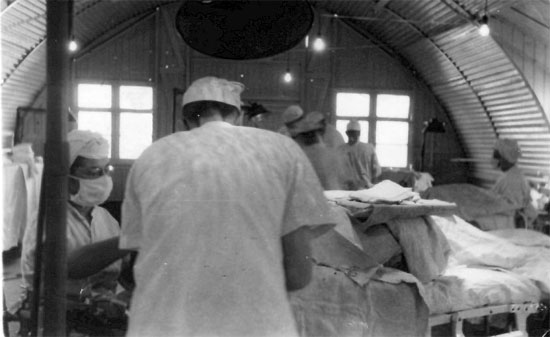
OR of the 164th Gen Hosp in action. At left, assisting the Surgeon, is 1st Lt. Ellan J. Levitsky (her sister is behind the Surgeon in front). Picture taken in April 1945 by Lt Col Frederick S. Harrell, CO 164th.
Before relinquishing control on 26 May, a reduced staff from the 164th Gen Hosp remained at the plant to further assist the new cadre and the German clinicians, awaiting further orders. In fact the 164th General Hospital closed down on 25 May 1945 and received instructions for transfer to the Naval Hospital (Hôpital Maritime) at Cherbourg, APO 562.
With respect to the new instructions the following situation developed:
Site # 1 – La Haye-du-Puits > 8048th Provisional German PW General Hospital (replaced 174th Gen Hosp, which initially started operation of Hospital Plant # 4271, 22 November 1944)
Site # 2 – La Haye-du-Puits > 8049th Provisional German PW General Hospital (replaced 176th Gen Hosp, which initially started operation of Hospital Plant # 4272, 23 November 1944)
Site # 3 – La Haye-du-Puits > 8047th Provisional German PW General Hospital (replaced 164th Gen Hosp, which initially started operation of Hospital Plant # 4273, 22 October 1944)
While European hostilities had now ceased, the unit felt it was destined to perform yet an important work, and there was much speculation as to where the Hospital would be sent on the other side of the world (Pacific Theater ?), and when the departure time would be. The Nurses rendered a particularly good job, though undoubtedly not a particular pleasant service in this regard. Since the services of only a minority were required at this stage, all advantages for rest, diversion and sightseeing were taken by all personnel. One Officer and 2 Nurses were fortunate to secure trips to England, and many Enlisted Men were accorded trips to Paris. With relief of duties and responsibilities of functioning, the unit enjoyed a well-earned rest of a few weeks at La Haye-du-Puits. During this period, 25 EM having high ASR scores were transferred out of the organization.
Finally orders were received and on 21 June 1945, the Hospital departed by rail for the Marseille Staging Area, carrying only limited equipment and provisions. The Medical Component, the Special Service equipment, the improvised equipment and facilities furnished in the area, were left behind. The train trip was slow and accommodation practically nil except for a seat in the car. Enlisted personnel slept on the floor in box cars (25 men per car), cars for Officers and Nurses were of the compartment-type with hard bench-like seats, but less crowded. K Rations were distributed for the journey, and at two points during the trips, the cars were unloaded and hot food was provided at a “transient mess” operated by an Army unit. After three days (450 mile-trip), the male personnel of the unit detrained at St. Martin-du-Crau (near Avignon). Large trucks convoyed the troops to the Arles Staging Area. The Nurses proceeded on the train to Marseille. Both components were to await further orders to proceed to the Pacific Area, insofar as was known at the time of arrival…
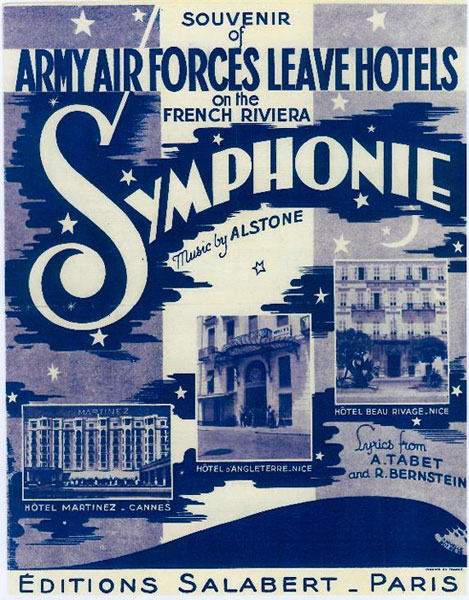
Leaflet containing French songs and lyrics provided by the USO, printed in Aug 45, and distributed to US Forces at the French Riviera Recreational Area. Courtesy of 2d Lieutenant Dorothy F. Sinner (ANC Officer, 164th Gen Hosp)
Separate instructions subsequently applied to male personnel and to Nurses, and while awaiting new orders, the unit prepared for Redeployment to a new Theater with following preparations:
- Clearance from the unit of high point Officers + EM and securing of comparable replacements for those removed
- Administration of preventive serums against diseases in the contemplated Theater (i.e. cholera), revaccination against smallpox, reimmunization against typhoid and tetanus for those who needed it
- Orientation by unit Officers regarding the contemplated Theater
- Lectures to Medical Officers by competent instructors on tropical diseases
- Courses in prevention against malaria required of all personnel
- Issuance of Mosquito Bars and Insect Repellent to all personnel
- Issuance of proper clothing to Enlisted personnel and procurement of proper clothing by Officers
- Insurance by inspections that equipment and clothing of all personnel was in serviceable condition
Officers and EM were housed in Squad Tents, varying in number from 10 to 14 men to each tent. Mess provision was under the direction of the 66th Infantry Division. As there were no mess halls, the men ate on the ground from individual mess kits. Activities were spent with recreation (trips to Marseille, to Lourdes, to the French Riviera, swimming in the Mediterranean), sports (intra-unit outdoor games), and instruction (lectures on GI Bill of Rights, War conditions, Postwar problems, etc).
The Nurses were billeted in stone or brick buildings, about 2 miles from the business district of Marseille. Major Carrie E. Barrett was still in charge, under jurisdiction of the Nurses Staging Area, and administered the first month (June) by the 235th General Hospital, and the last few weeks by the 7th Convalescent Hospital. These administrative functions were assisted by Personnel Division, Delta Base, under the direction of Major Lacy, ANC. Captain Signe C. Wold, Asst Chief Nurse was removed from the unit and replaced by Captain Emma E. Rose, ANC. The housing was good, the food was fine, and recreational facilities were provided, such as swimming, outdoor exercise, and dancing. In addition all Nurses were likewise given instruction, clothing, and equipment for further overseas duty.
In the Arles Staging Area, reconstitution of the 164th General Hospital was effected, and the unit was now designated Category II for Direct Redeployment. High Point Enlisted Men were withdrawn and replacements sent in. 29 EM were removed, and 55 replacements received. 16 Officers (including Nurses) left and 21 (including Nurses) were received. Lt Col W. T. Barron, XO, left the unit and was replaced; Lt Col Paul B. Sheldon, the Chief of Medical Service, also left, and got replaced; and Maj George W. Gay, Chief of Surgical Service, was also removed and replaced.
Plans were practically completed for departure, when V-J Day came. Plans to redeploy directly to the Pacific Area continued even after the surrender of Japan, but a few days prior to embarking, it was learned that there was a possibility of going direct to the United States!

Some unidentified members of the medical surgical teams are taking a break. Second from right is Nurse Ellan J. Levitsky.
Final orders were received and the Marseille Port sailing date was fixed on 23 August 1945. The 164th sailed at 1800 hours on US Naval Transport “General Charles G. Morton”, and debarked at Newport News, Virginia at 2000 hours, 2 September 1945. Two hours after arrival, the unit was on a train bound for Camp Patrick Henry, some 10 miles away. Upon arrival, all personnel were given an outstanding meal of steak, milk, eggs, and ice cream, food which had been rare in France.
Inactivation:
After three days in Camp Patrick Henry, groups were now formed to go to the Reception Station nearest their homes via troop trains. The Camp of reassembly was to be Camp Sibert, Alabama. At the Reception Stations orders were expeditiously prepared providing a temporary duty 30 days rest and recuperation period, augmented by another 15-day period. Lt Colonel F. S. Harrell (CO > 164th Gen Hosp), returned to the new Camp on 23 October followed a few days later by other Officers and EM. Adequate wooden barracks were provided for all, the Nurses being billeted in a separate area. A unit mess hall was opened on 27 October. Upon return of 75% of personnel, preparations for inactivation were started and the date was set for 9 November 1945. Lt Col F. S. Harrell left the unit on 1 November (for reasons of pre-Pearl Harbor service), and was replaced by Lt Colonel Charles S. McWilliam (XO).
Activities during the inactivation period consisted mainly of transfer out of personnel, preparation of official records, pay vouchers and payrolls, as well as disposal of property. Many Officers and Enlisted Men were separated from the service at the various Reception Stations and Separation Centers, and the remainder left at Camp Sibert, Attalia, Alabama.
All Enlisted Men, except a cadre of 35, were transferred from the unit. The remaining cadre completed the Separation process, turned in equipment, packed records, and forwarded everything to its proper destination. On 9 November, the mess supplied a final meal at 1600 hours, and then prepared it for final inspection. All other areas were given a final cleaning and the remaining Officers and EM were taken to another part of the Post.
At 2400 hours, 9 November 1945, the 164th General Hospital was inactivated, its mission having been completed!
Command and Staff (incomplete roster):
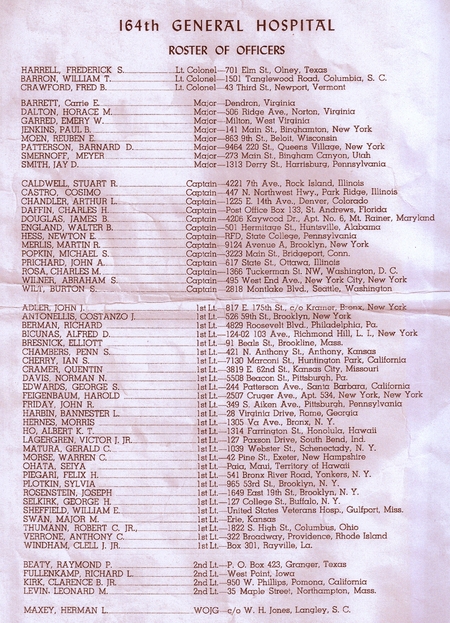
Roster of Officers – 164th General Hospital, listed in the Souvenir Program, Camp Grant, Illinois, 24 August 1944.
Courtesy of Joe R. Castro (son of Captain Cosimo “Sam” Castro, 164th Gen Hosp).
| Lt. Colonel Frederick S. HARRELL | Commanding Officer (replaced by Lt Col Charles S. McWilliam) |
| Lt. Colonel William T. BARRON | Executive Officer (replaced by Lt Col Charles S. McWilliam) |
| Lt. Colonel Fred B. CRAWFORD | Chief of Dental Service (replaced by Maj James N. Crawford) |
| Lt. Colonel Paul B. SHELDON | Chief of Medical Service (replaced by Maj Lucian M. Ferris) |
| Major George W. GAY | Chief of Surgical Service (replaced by Lt Col William J. Stewart, followed by Maj Roland F. Elkins) |
| Major Carrie E. BARRETT | Chief Nurse & Head of Nursing Staff |
| Captain Burton S. WILT | Asst Chief of Medical Service |
| Captain C. WOLD | Asst Chief Nurse (replaced by Capt Emma E. Rose) |
| Captain John A. PRICHARD | P & T Officer |
| Captain James E. DOUGLAS | X-Ray Department |
| Captain Charles H. DAFFIN | Head of Medical Laboratory |
| Miss Esther BALLARD | Director Red Cross |
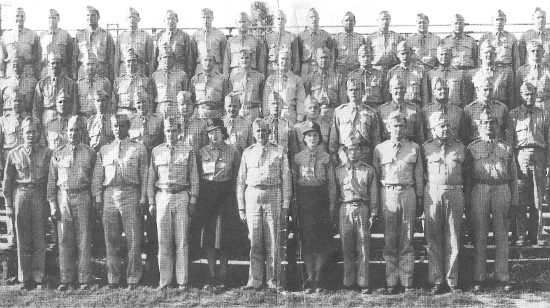
Group picture illustrating Officer personnel of the 164th General Hospital, dated August 1944.
Courtesy of Joe R. Castro (son of Captain Cosimo “Sam” Castro, 164th Gen Hosp).
Some of the above images are courtesy of 1st Lt. Ellan J. Orkin (ASN: N-762232) and 2d Lt. Dorothy F. Sinner (ASN: N-762231). Both Nurses served overseas with the 164th General Hospital. Extra illustrations kindly provided by Joe R. Castro, son of Capt. Cosimo “Sam” Castro.
